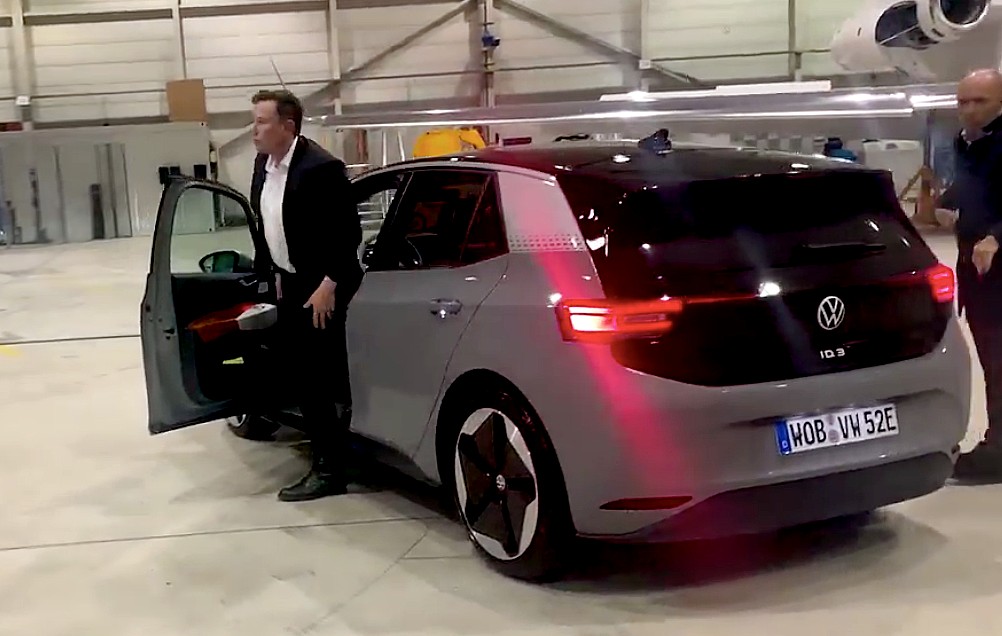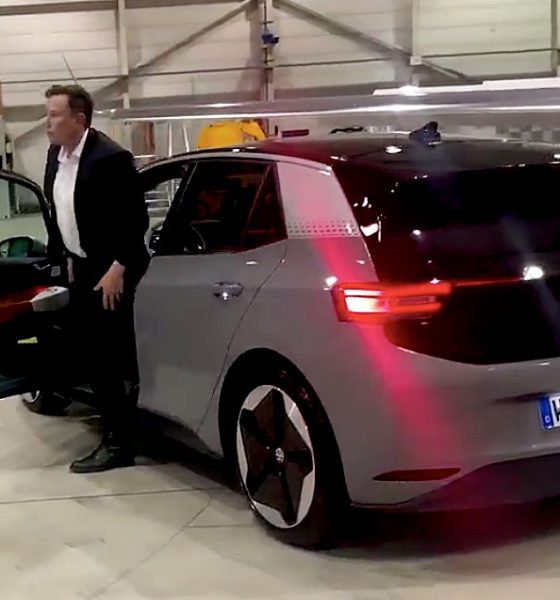

News
Volkswagen gets FUD over its “irritatingly energetic” EV strategy
Volkswagen is serious about its electric vehicle business. This is evident in the German automaker’s efforts to release its first mass-market electric car, the ID.3. The vehicle has received its own fair share of acclaim and criticism since its release, but as Volkswagen continues its EV push with the ID.4 crossover, it appears that the veteran automaker is now dealing with something that Tesla has been battling: anti-electric car FUD.
In a recent article on Cicero Magazine, author Nils Heisterhagen sharply criticized Volkswagen for its “irritatingly energetic” focus on electric vehicles. The author questioned the veteran automaker’s dedication to battery-only vehicles, stating that alternative fuels are a better option, since most cars will have a combustion engine in the future anyway. “Shouldn’t we focus on synthetic fuels when most cars will have combustion engines in the foreseeable future?” the EV critic noted.
The author also criticized Volkswagen for pushing electric cars so much when the development of charging infrastructure for EVs will be extremely expensive. Heisterhagen cited a study from the Handelsblatt Research Institute claiming that 1,000,000 electric cars would require the support of 100,000 charging stations. Considering these challenges, the author argued that it would have been more practical if Volkswagen had focused on alternative fuels like hydrogen instead.
“Building the charging infrastructure is extremely expensive. For Germany alone, we are talking about multi-billion investments by 2030 – and that in addition to the existing filling station infrastructure. So why not use the existing filling station infrastructure – for hydrogen and e-fuels?” Heisterhagen wrote, lamenting the automaker’s resistance to hydrogen and other alternative fuels.
Electric mobility expert Auke Hoekstra has responded to Heisterhagen’s points, defending Volkswagen and setting the record straight about why all-electric vehicles will likely be the reason why the veteran German automaker will thrive in the EV age. According to Hoekstra, the author’s points don’t hold any water since synthetic fuels require a lot of energy and are thus extremely expensive. This is the same for e-fuels and hydrogen.
This is extremely ironic considering that the author was criticizing EVs over the cost of their charging infrastructure. Hoekstra noted that if one were to run the numbers, the massive costs associated with the rollout of an EV charging infrastructure would likely be “pocket change” compared to the costs of developing and transitioning into alternative fuels. With this in mind, the electric mobility expert argued that the aggressive EV push from Volkswagen is a step in the right direction after all.
“I must say that the “irritatingly energetic” (the writer’s words) of the electric drivetrain by Volkswagen is the only reason still see a future for the German car industry,” Hoekstra wrote.
Volkswagen’s EV push has earned the respect of electric car leaders like Tesla CEO Elon Musk, who previously stated that the automaker, under the guiding hand of Herbert Diess, is “doing more than any big carmaker to go electric.” Musk has shown his support for Volkswagen’s electric car efforts, even test-driving the ID.3 with Diess during his recent visit to Germany. A video taken during the test drive showed that the Tesla CEO and the VW executive were on friendly terms, with Musk even joking “What’s the worst that could happen?” while flooring the ID.3.

News
Tesla FSD fleet is nearing 7 billion total miles, including 2.5 billion city miles
As can be seen on Tesla’s official FSD webpage, vehicles equipped with the system have now navigated over 6.99 billion miles.

Tesla’s Full Self-Driving (Supervised) fleet is closing in on almost 7 billion total miles driven, as per data posted by the company on its official FSD webpage.
These figures hint at the massive scale of data fueling Tesla’s rapid FSD improvements, which have been quite notable as of late.
FSD mileage milestones
As can be seen on Tesla’s official FSD webpage, vehicles equipped with the system have now navigated over 6.99 billion miles. Tesla owner and avid FSD tester Whole Mars Catalog also shared a screenshot indicating that from the nearly 7 billion miles traveled by the FSD fleet, more than 2.5 billion miles were driven inside cities.
City miles are particularly valuable for complex urban scenarios like unprotected turns, pedestrian interactions, and traffic lights. This is also the difference-maker for FSD, as only complex solutions, such as Waymo’s self-driving taxis, operate similarly on inner-city streets. And even then, incidents such as the San Francisco blackouts have proven challenging for sensor-rich vehicles like Waymos.
Tesla’s data edge
Tesla has a number of advantages in the autonomous vehicle sector, one of which is the size of its fleet and the number of vehicles training FSD on real-world roads. Tesla’s nearly 7 billion FSD miles then allow the company to roll out updates that make its vehicles behave like they are being driven by experienced drivers, even if they are operating on their own.
So notable are Tesla’s improvements to FSD that NVIDIA Director of Robotics Jim Fan, after experiencing FSD v14, noted that the system is the first AI that passes what he described as a “Physical Turing Test.”
“Despite knowing exactly how robot learning works, I still find it magical watching the steering wheel turn by itself. First it feels surreal, next it becomes routine. Then, like the smartphone, taking it away actively hurts. This is how humanity gets rewired and glued to god-like technologies,” Fan wrote in a post on X.
News
Tesla starts showing how FSD will change lives in Europe
Local officials tested the system on narrow country roads and were impressed by FSD’s smooth, human-like driving, with some calling the service a game-changer for everyday life in areas that are far from urban centers.

Tesla has launched Europe’s first public shuttle service using Full Self-Driving (Supervised) in the rural Eifelkreis Bitburg-Prüm region of Germany, demonstrating how the technology can restore independence and mobility for people who struggle with limited transport options.
Local officials tested the system on narrow country roads and were impressed by FSD’s smooth, human-like driving, with some calling the service a game-changer for everyday life in areas that are far from urban centers.
Officials see real impact on rural residents
Arzfeld Mayor Johannes Kuhl and District Administrator Andreas Kruppert personally tested the Tesla shuttle service. This allowed them to see just how well FSD navigated winding lanes and rural roads confidently. Kruppert said, “Autonomous driving sounds like science fiction to many, but we simply see here that it works totally well in rural regions too.” Kuhl, for his part, also noted that FSD “feels like a very experienced driver.”
The pilot complements the area’s “Citizen Bus” program, which provides on-demand rides for elderly residents who can no longer drive themselves. Tesla Europe shared a video of a demonstration of the service, highlighting how FSD gives people their freedom back, even in places where public transport is not as prevalent.
What the Ministry for Economic Affairs and Transport says
Rhineland-Palatinate’s Minister Daniela Schmitt supported the project, praising the collaboration that made this “first of its kind in Europe” possible. As per the ministry, the rural rollout for the service shows FSD’s potential beyond major cities, and it delivers tangible benefits like grocery runs, doctor visits, and social connections for isolated residents.
“Reliable and flexible mobility is especially vital in rural areas. With the launch of a shuttle service using self-driving vehicles (FSD supervised) by Tesla in the Eifelkreis Bitburg-Prüm, an innovative pilot project is now getting underway that complements local community bus services. It is the first project of its kind in Europe.
“The result is a real gain for rural mobility: greater accessibility, more flexibility and tangible benefits for everyday life. A strong signal for innovation, cooperation and future-oriented mobility beyond urban centers,” the ministry wrote in a LinkedIn post.
News
Tesla China quietly posts Robotaxi-related job listing
Tesla China is currently seeking a Low Voltage Electrical Engineer to work on circuit board design for the company’s autonomous vehicles.

Tesla has posted a new job listing in Shanghai explicitly tied to its Robotaxi program, fueling speculation that the company is preparing to launch its dedicated autonomous ride-hailing service in China.
As noted in the listing, Tesla China is currently seeking a Low Voltage Electrical Engineer to work on circuit board design for the company’s autonomous vehicles.
Robotaxi-specific role
The listing, which was shared on social media platform X by industry watcher @tslaming, suggested that Tesla China is looking to fill the role urgently. The job listing itself specifically mentions that the person hired for the role will be working on the Low Voltage Hardware team, which would design the circuit boards that would serve as the nervous system of the Robotaxi.
Key tasks for the role, as indicated in the job listing, include collaboration with PCB layout, firmware, mechanical, program management, and validation teams, among other responsibilities. The role is based in Shanghai.
China Robotaxi launch
China represents a massive potential market for robotaxis, with its dense urban centers and supportive policies in select cities. Tesla has limited permission to roll out FSD in the country, though despite this, its vehicles have been hailed as among the best in the market when it comes to autonomous features. So far, at least, it appears that China supports Tesla’s FSD and Robotaxi rollout.
This was hinted at in November, when Tesla brought the Cybercab to the 8th China International Import Expo (CIIE) in Shanghai, marking the first time that the autonomous two-seater was brought to the Asia-Pacific region. The vehicle, despite not having a release date in China, received a significant amount of interest among the event’s attendees.








